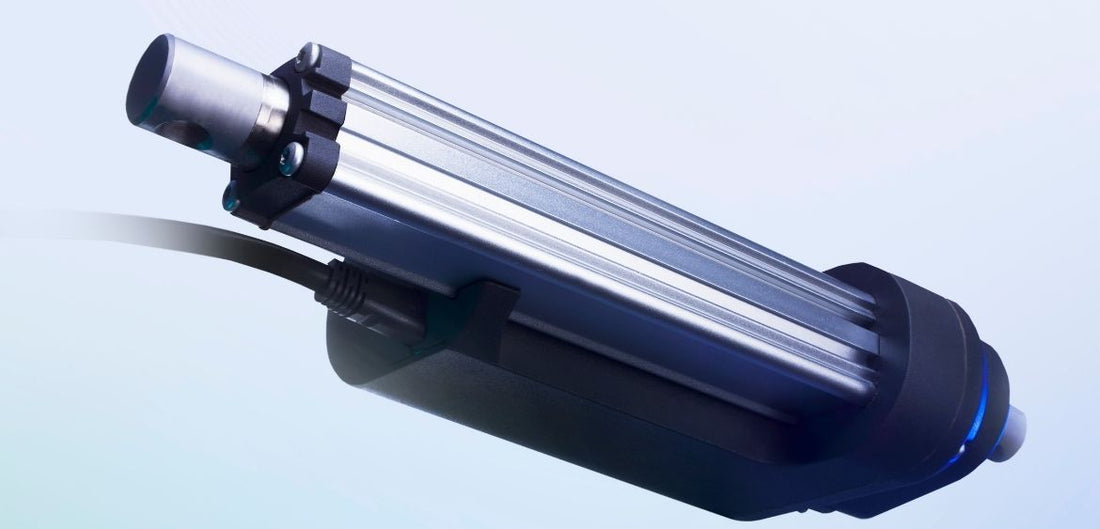An actuator is a motor that transfers energy from whatever is powering it into motion. This explanation may sound simplistic, but at heart, that's what it does. Within that simplicity lies a great deal of utility; the majority of modern devices that involve motion of any kind could not exist without these components. For example:
In NASA's Mars Rover: It's full of actuators. The most important power the wheels and the sample collection tool. They are so important that NASA actually tests to double their rated specifications and lifetimes before signing off on them.
In Your Car: Have power locks or power windows? Those are linear motors providing all that motion. Cruise Control? Same thing. The modern automobile has over 100 actuators in it, helping you steer, brake, adjust your mirrors, pop your headlight covers, adjust your seat, trim the air vents, or even just to make the windshield wipers move. And in the trunk, you probably have a car jack, which is another kind of linear device.
In Your Robots: Just about every robot you've ever seen requires linear motion tech to function. Moving the arms, legs, eyes, and head. Honda's ASIMO robot contains three very powerful ones to allow it to walk. And yes, this includes the Roomba.
In Your Movies: Nearly every mobile prop in a Hollywood film has actuators in it, including robots. When does a car fly in the air after an explosion? That's usually a really big actuator that's triggered at the same time as the explosion, sending that thing flying.
In Your iPhone: Inside every vibrating phone is a mini-actuator, which rattles back and forth rapidly to create that signature buzzing.
The list could go on and on. The problem with these devices is that they do so much, and in so many different ways, that's it hard to wrap your head around how they actually work. Let's revisit the original definition: A motor that transfers energy from whatever is powering it into motion. After reading some of the examples above that should hopefully make more sense; the iPhone takes battery power and makes an actuator fire rapidly within it, the result is a back and forth vibratory motion.
The new Mars Rover 'Curiousity' takes energy from a Plutonium mini-generator, and uses it to power the devices in the wheels, resulting in forwarding motion. The Hollywood stunt car flipper takes energy from a compressed gas (usually nitrogen) and moves once, very powerfully, causing the car to fly into the air. All of these examples use different power sources, fire off the actuator at different rates, and all have markedly different effects. A simpler description would be a linear cylinder is a thing that makes other things move.
How does it work?
There are as many kinds of actuators as there are automation applications for them, but each of them is based around one of the classic simple machines (screw, wheel, and axle, lever, wedge, pulley, etc.). Examining each of these in detail would take quite a while, and is beyond the scope of this article. Instead, let's jump straight into the screw design.
The way it works is you have a screw, and on the screw is a nut. By holding the nut still in one hand, and turning the screw with the other, you are generating linear motion in the screw itself (e.g. it travels back and forth in a straight line depending on which direction you are turning it). This is an elegant solution because you are converting rotational motion (the force exerted on the screw) into linear motion (the screw bolt traveling through the nut), in a remarkably small space. There's also a lot of flexibility present since you can change the pitch of the screw threads, the length of the bolt, the size of the nut, etc.
The classic machine example above translates easily into modern engineering. Instead of holding the nut tight with your hand, it's encased in a tubular mounting that moves up and down with the nut. Instead of turning the screw with your other hand, it can be linked up to a simple 12 volt DC electric motor. The motor turns the screw, the screw, in turn, moves the nut up/down its length. You now have a basic device that can be used in a variety of ways.
Learn everything you need to know about linear actuators.
By taking rotational motion and converting it into linear motion, a linear actuator efficiently and predictably puts a lot of force into a relatively small area. This is important because the majority of uses of actuators (automobiles, robotics, electronics, etc.) put a premium on both space and weight. Pneumatic and hydraulic actuators (where the force is created by pressure differentials in a liquid or gas) are powerful and varied, but they tend to take more space than an electric linear actuator of the same force/rating.
To give you a better understanding of how these electric devices work, let's take a look at the anatomy of one:
Electric Motor
The electric motor serves as the power source for the actuator, in this case usually an electric 12 volt DC motor. The energy is transmitted via a belt to gears.
Gears
The gear turns from the motor above, and in turn, rotates the screw or bolt.
Screw/Bolt
This is where the magic happens. The screw is usually the biggest piece of the actuator. The screw turns from the force of the electric motor and forces itself through a nut. This motion pushes the screw forward, extending it.
Internal Seal
The internal seal prevents dust, liquids, and other matter from getting inside the actuator and gumming up the screw, nut, or gears.
Rod or Plunger
This is where the actuator interacts with the outside world. Nearly anything can be connected to the plunger; a rod, a wire, a valve, a button. The rod is what manipulates an external object, and harvests the force provided by the actuator.
A note about electric motors: All ProgressiveAutomations electric linear actuators have a built-in limit switch at the end of each extension (e.g. fully retracted and fully extended). This turns off the motor (without disabling the power) automatically when the actuator is 'locked' at full extension. This prevents the motor from over-running (extending the life of the actuator) and saves on electricity consumed.
Now that you know the parts, you should know what strengths and kinds of the linear actuators are available. There are four main criteria to consider when classifying an actuator.
Stroke
The Stroke is the amount of distance the screw can travel before it is fully extended; usually measured in inches. Small actuators can have a stroke of 1 or 2 inches, but it can go up to 12 inches, 24 inches, or even more for custom actuators. There is a trade-off though, between stroke length, speed, and force.
Speed
The Speed is how fast the screw travels through the nut, or how quickly the rod/plunger 'moves'. This can vary depending on the application. Actuators that have to push a lot of force are generally slower (e.g. 0.24 inches per second) while lighter weight actuators can be much faster (e.g. anywhere from 1 inch to 9 inches per second).
Force
The Force (or push/pull force) of an actuator is how much force it outputs at the rod/plunger end, and is usually measured in pounds. This is basically how hard a linear actuator can 'push' something. Force varies between models and can be as low as 15 pounds going all the way up to 2000 pounds or more for certain heavy-duty industrial applications.
Lock-Up Force
This is similar to Force but refers instead to how much weight the actuator can support by itself before the screw is pushed back in. So an actuator may be able to 'push' 100 pounds of force, but can only support the weight of a 50-pound object directly resting on it. This is usually measured as the number of pounds the actuator can support when not in motion, e.g. in 'locked' mode. This also varies from model to model but at minimum is usually the same as the Push/Pull force, and in some cases can support four times as much as weight.
So now you know a bit more about how linear actuators are put together, and what attributes define them. One thing to keep in mind is that the Stroke, Force, Speed, and Weight Capacity all influence each other, and can cause diminishing returns in one area depending on the value of another. For example, an actuator with a high Force/Weight Capacity generally doesn't have a high speed; this is because the nut and screw have to be designed to exert the maximum amount of force, and speed is usually what is sacrificed. This doesn't mean that heavy load, high-speed actuators don't exist (ask us about them in our custom orders section), but rather they're not commonly used.




